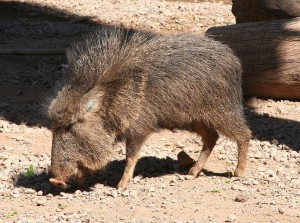
My name is Micaela Camino, I am an Argentine biologist working in one of the most amazing places I have ever seen: Chaco, where I work with one of the most unique species on earth: the Chacoan peccary.
I have travelled around many different environments in South America, the highest mountains of the continent, the driest deserts on earth, huge rivers, giant, beautiful and endless jungles like Amazonia. But Chaco is my choice, the place where I stayed putting all my energy and passion for its conservation.
There is something magical about Chaco, something full of mystery; a region that is alive. Something in Chaco I cannot explain, hundreds of kilometres of continuous natural environments, different habitats creating heterogeneous landscapes. Imagine travelling through the wilderness for days without seeing a city. After Amazonia, Chaco is the second largest eco-region of America and it is seriously endangered by habitat loss.
My project location is the Semiarid portion of Chaco, a centre of cultural diversity and rich biodiversity, with many endangered and unique species. It also has extremely high temperatures in summer and lack of water in winter, and trees that look as if they were caught in a dance and had to remain still while you watch. You can feel the wilderness all around you.

I studied biology in the University of Buenos Aires, in Argentina; and I am finishing my Ph.D. there. I have always been interested in large wild mammal conservation, and in understanding their interaction with natural and human factors. Chaco is populated by indigenous and mestizo people who live in isolated houses or communities, surrounded by natural environments and with great knowledge of nature. In 2011, we started a wildlife monitoring system that still functions, where local people participate of decisions and collect field-information. I also studied habitat requirements of peccaries (white lipped peccary, Tayassu pecari; collared peccary, Pecari tajacu; and Chacoan peccary, Catagonus wagneri). The findings were alarming, and highlighted that actions for the conservation of these species and their environments are urgent.
Based on those results I designed a new project, with the focus on the most threatened and evolutionary unique of these species: the Chacoan peccary. This species is ranked 17 in the evolutionary distinct and globally endangered species list (EDGE) and considered Endangered by IUCN. It is endemic to the Dry Chaco and action for its conservation are crucial as its distribution range and individual abundance are decreasing. This project will undertake vital research and design conservation actions with the hope of saving this species from extinction. There is a lot to do…
Read my next post to learn more about Chacoan peccaries, why they are so unique and important and what will this project do to save the last Chacoan peccaries.
